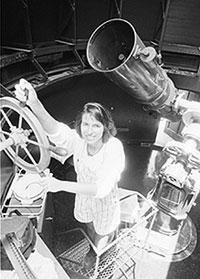Elizabeth Warner
Liaison to Amateur Astronomers, Deep Impact

What is the coolest thing about the Deep Impact mission?
That's a hard one! I see many different aspects of the mission from the interaction between the engineers and scientists to the collaboration with amateurs. But for me, the coolest thing will be to observe the comet over several weeks and then hopefully (weather-permitting) see it on 4 July a bit brighter than on the previous nights and to know that we made it brighter. As for images from the spacecraft, I think what I'm really looking forward to is seeing the images from the impactor as it heads toward its collision with Comet Tempel 1. (When the impactor hits the comet, it will excavate a crater throwing a bunch of gas and dust into the comet's coma. With more gas and dust to reflect sunlight, the comet appears brighter to observers on Earth.)
Why do you like working at the University of Maryland?
Working in an academic setting is very flexible and I actually have other duties within the department that complement nicely with my duties on the Deep Impact project.
How are you associated with the Deep Impact mission?
My official title is "Liaison to Amateur Astronomers" which means that I get paid to go to astronomy clubs and starparties to give presentations about Deep Impact. That is just really cool, because amateur astronomy is also a hobby for me and I enjoy going to these events. Now I get paid to do it! But I also have other roles on the mission. I also serve as co-curator for the mission website overseeing content for the Science and Technology portions primarily and other parts as needed. I help answer email questions. I'm also the webmaster for the Small Telescope Science Program and Amateur Observers' websites.
How did you end up working in space science?
I was in the right place at the right time. Answering the door when opportunity knocked. I know those are cliches, but if I gave you the whole story, you'd see that those cliches ring true in my case!
What is your everyday work life like?
Most days, I come in and answer emails, answer some questions that come in through our web site, go to a meeting or two, work on some part of one of the websites. Some days, I'll also meet with students who are working on some project. I might also have to go to the campus observatory some evenings for Open House or a class.
What do you do in your spare time?
Spare time, are you kidding? Well, I really like to read, but I have to make sure there aren't too many unread books around or I might be tempted to call in sick! I also like to go observing with my telescopes when I can, bicycling when the weather is nice, and when we are on vacation, I like to go fishing and hiking.
What is one yet-to-be achieved life goal?
I want to build a large telescope (about 20") including grinding the mirror myself and then use it to discover an asteroid or comet!
What do you hope to learn from the Deep Impact mission?
I am really enjoying learning about how a mission works -- seeing all the aspects from the inside. It gives me a much greater appreciation for the amount of time and effort put into past missions that I followed as a member of the "general public."
What did you want to be when you were a kid?
I wanted to be a scientist! Anykind! If it ended in -ology, -onomy, -ography, then I probably wanted to be that! Geology, archeology, oceanography, oceanology, biology, astronomy, geography -- the influence of National Geographic!
Who inspired you?
My parents. They came to America (from eastern Europe long before the wall fell!), took advantage of the wonderful opportunities here and gave me a chance at those opportunities as well.
Were you a science-oriented kid?
Yes. Both of my parents are engineers, but they always encouraged me and my brother to learn and explore. We went to one of the first shuttle launches. We went rock hunting (Kids love to dig in the dirt. Why not make them look for arrowheads, shark's teeth and sundry gems while they are doing it?!). And while I liked all types of science, my favorite was astronomy, so they got me a subscription to Astronomy magazine and when I was older, they helped me to buy my first telescope.
What was your favorite book as a teenager?
My favorite was the Foundation Trilogy by Isaac Asimov. Each summer, we would spend a week at the beach and each summer I read that trilogy. I don't remember how many times I read it, but I would spend a few hours each day reading. When I was younger, I liked reading Swiss Family Robinson over and over. I think my Mom finally told me I couldn't check that one out from the library anymore! In general, I enjoy reading scifi, some historical fiction, some mysteries, Star Wars and Star Trek... actually, I really do enjoy reading so naming all of the books would be tough, but Asimov was a clear favorite!
Do you have any advice for young scientists?
Study! And be open to opportunities!











